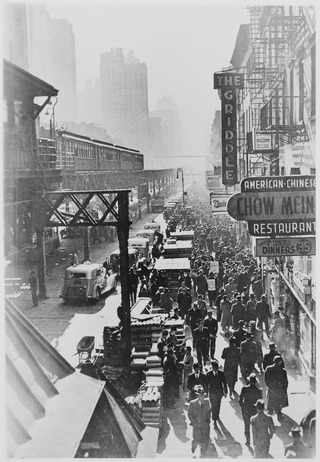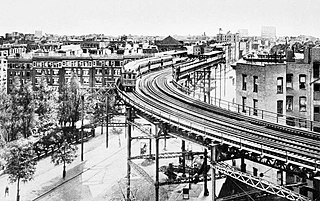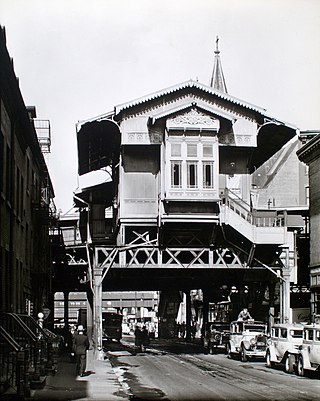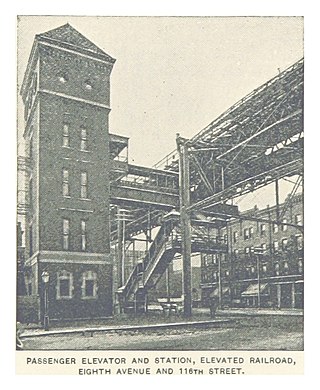
The 167th Street station is a local station on the IRT Jerome Avenue Line of the New York City Subway. Located at the intersection of 167th Street and River Avenue in the Bronx, it is served by the 4 train at all times. This station was constructed by the Interborough Rapid Transit Company as part of the Dual Contracts and opened in 1917.

The IRT Ninth Avenue Line, often called the Ninth Avenue Elevated or Ninth Avenue El, was the first elevated railway in New York City. It opened in July 1868 as the West Side and Yonkers Patent Railway, as an experimental single-track cable-powered elevated railway from Battery Place, at the south end of Manhattan Island, northward up Greenwich Street to Cortlandt Street. By 1879 the line was extended to the Harlem River at 155th Street. It was electrified and taken over by the Interborough Rapid Transit Company in 1903.
The Lenox Avenue Line is a line of the New York City Subway, part of the A Division, mostly built as part of the first subway line. Located in Manhattan, New York City, it consists of six stations between Central Park North–110th Street and Harlem–148th Street, all of which are situated within the neighborhood of Harlem in Upper Manhattan.

The IRT Sixth Avenue Line, often called the Sixth Avenue Elevated or Sixth Avenue El, was the second elevated railway in Manhattan in New York City, following the Ninth Avenue Elevated.

110th Street is a street in the New York City borough of Manhattan. It is commonly known as the boundary between Harlem and Central Park, along which it is known as Central Park North. In the west, between Central Park West/Frederick Douglass Boulevard and Riverside Drive, it is co-signed as Cathedral Parkway.

The Central Park North–110th Street station is a station on the IRT Lenox Avenue Line of the New York City Subway, located at the intersection of 110th Street and Lenox Avenue at the southern edge of Harlem, Manhattan. It is served by the 2 and 3 trains at all times.

The 161st Street–Yankee Stadium station is a New York City Subway station complex shared by the elevated IRT Jerome Avenue Line and the underground IND Concourse Line. It is located at the intersection of 161st Street and River Avenue in the Highbridge and Concourse neighborhoods of the Bronx. It is generally served by the 4 train at all times; the D train at all times except rush hours in the peak direction ; and the B train during rush hours.
The Battery Place station was a station on the demolished Ninth Avenue and Sixth Avenue elevated train lines in Manhattan, New York City. It was located at the southern terminus of Greenwich Street at the north end of Battery Park.
The Franklin Street station was a local station on the demolished IRT Ninth Avenue Line in Manhattan, New York City. It had three tracks and two side platforms. It was served by trains from the IRT Ninth Avenue Line. It opened on January 21, 1873, and closed on June 11, 1940. The next southbound stop was Warren Street. The next northbound stop was Desbrosses Street.

The Christopher Street station was an express station on the demolished IRT Ninth Avenue Line in Manhattan in New York City. It had three tracks, one island platform and two side platforms. It was served by trains from the IRT Ninth Avenue Line. It opened on November 3, 1873 and closed on June 11, 1940. On February 25, 1908, the Hudson and Manhattan Railroad built a subway station just east of this station as part of the extension between Hoboken and 33rd Street. The next southbound local stop was Houston Street. The next southbound express stop was Desbrosses Street. The next northbound stop was 14th Street for all trains.
The 30th Street station was a local station on the demolished IRT Ninth Avenue Line in Manhattan, New York City. It was opened on December 13, 1873 as the replacement for the original northern terminus of the Ninth Avenue Line at 29th Street, which was built in 1868 The station which was originally built by the New York Elevated Railroad Company had two levels. The lower level was built first and had two tracks and two side platforms. The upper level was built as part of the Dual Contracts and had one track that served express trains that bypassed the station. It closed on June 11, 1940. The next southbound stop was 23rd Street. The next northbound stop was 34th Street.
The 66th Street station was an express station on the demolished IRT Ninth Avenue Line in Manhattan, New York City. It had two levels. The lower level was built first and had two tracks and two side platforms. The upper level was built as part of the Dual Contracts and had one track and two side platforms over the lower level local tracks. The station closed on June 11, 1940. The next southbound local stop was 59th Street. The next southbound express stop was 34th Street for Ninth Avenue trains, and 50th Street for IRT Sixth Avenue Line express trains. The next northbound local stop was 72nd Street. The next northbound express stop was 116th Street. The express run from this stop to 116th Street was the longest express segment out of all New York City elevated lines, bypassing seven local stations.

The 42nd Street station was a local station on the demolished IRT Ninth Avenue Line in Manhattan, New York City. It was opened on November 6, 1875, and had two levels. On the lower level, the local trains stopped, on two tracks serving two side platforms. The upper level was built as part of the Dual Contracts and had one track which carried express trains bypassing the station. The next northbound stop was 50th Street. The next southbound stop was 34th Street. The station was closed on June 11, 1940.
The 86th Street station was a local station on the demolished IRT Ninth Avenue Line in Manhattan, New York City. It had two levels. The lower level was built first and had two tracks and two side platforms and served local trains. The upper level was built as part of the Dual Contracts and had one track that served express trains that bypassed this station. It opened on June 21, 1879 and closed on June 11, 1940. The next southbound stop was 81st Street. The next northbound stop was 93rd Street.
The 104th Street station was a local station on the demolished IRT Ninth Avenue Line in Manhattan, New York City. It had two levels. The lower level was built first and had two tracks and two side platforms and served local trains. The upper level was built as part of the Dual Contracts and had one track that served express trains that bypassed this station. It opened on June 21, 1879, and closed on June 11, 1940. The next southbound stop was 99th Street. The next northbound stop was 116th Street station until June 3, 1903, and then 110th Street. This had a view of the Suicide Curve at 110th Street.

The 116th Street station was an express station on the demolished IRT Ninth Avenue Line in Manhattan, New York City. It had three tracks and two island platforms. It opened on September 17, 1879, and closed on June 11, 1940. The next southbound local stop was 104th Street station until June 3, 1903, and then 110th Street. The next southbound express stop was 66th Street. The next northbound stop was 125th Street for all trains. The express run from this stop to 66th Street was the longest express segment out of all New York City elevated lines, bypassing seven local stations.
The 125th Street station was an express station on the demolished IRT Ninth Avenue Line in Manhattan, New York City. It had three tracks and two island platforms. It opened on September 17, 1879, and closed on June 11, 1940. The next southbound stop was 116th Street for all trains. The next northbound local stop was 130th Street. The next northbound express stop was 145th Street.
The 151st Street station was a local station on the demolished IRT Ninth Avenue Line in Manhattan, New York City. It had 2 levels. The lower level had two tracks and two side platforms and served local trains. The station was built as part of the Dual Contracts and had one track that served express trains that bypassed this station. The next stop to the north was 155th Street. The next stop to the south was 145th Street. The station opened on November 15, 1917 and closed on June 11, 1940.










